
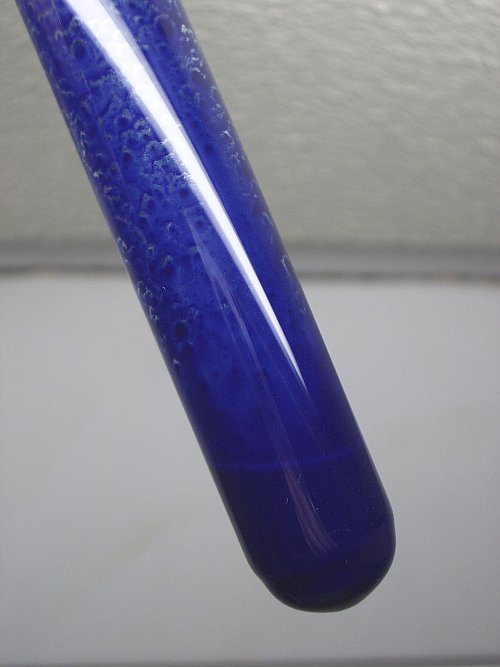

Aqueous solutions and precipitates of niobium
Niobium has a remarkably interesting aqueous chemistry, despite its strong tendency to hydrolyse. It can exist in aqueous solution in its +4 and +5 oxidation states, but only at very low pH. In neutral aqueous solution, no simple niobium compound can remain in solution.
The aqueous chemistry of the metal in its +5 oxidation state is fairly limited, and the keyword to understanding that chemistry is 'hydrolysis'. The aqueous chemistry of the metal in its +4 oxidation state, however, is remarkably diverse and still, its chemistry is not yet fully understood.
![]()
Oxidation state +4
The element niobium is most stable in its +5 oxidation state, but one can obtain the element in its +4 oxidation state by reduction with zinc in strongly acidic solution. Such solutions are strongly reducing and when left in contact with air, they quickly are oxidized.
When a really tiny amount of metallic zinc is added to a colorless solution of niobium pentachloride in concentrated hydrochloric acid, then the solution becomes blue. When more zinc is added, then the solution at once turns deep blue and it becomes turbid. This blue compound is said to be niobium tetrachloride, NbCl4.
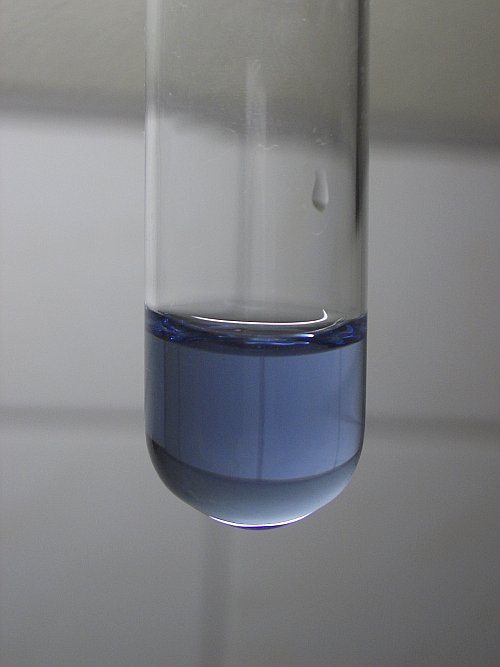

Niobium tetrachloride is a covalent compound, just like niobium pentachloride. In aqueous environments, it only can exist in highly acidic solutions, otherwise it is hydrolysed.
When the dark blue liquid is strongly diluted (two ml of liquid, mixed with 250 ml of water), one still obtains a dark blue liquid, but now this liquid is totally clear. The solid matter in the test tube, shown above, then dissolves and a nice deep blue liquid remains. The blue color, however, quickly fades in the diluted liquid. The color of the liquid goes from dark blue to colorless in one minute or so. This most likely is due to dissolved oxygen in the water, which oxidizes the blue compound to a colorless niobium (V) species. On longer standing, the colorless liquid becomes white/turbid, due to slow hydrolysis (see below in the section for oxidation state +5).
Mixed oxidation state complex?
When the blue liquid is strongly diluted with water, in the presence of some zinc metal, then also the blue color quickly fades, but in that case, the color goes to light brown instead of colorless. That transition also takes approximately 1 minute. This is shown by doing the following experiment:
- Take the test tube with the dark blue liquid and the solid material in it, as shown in the picture above.
- Decant almost all of the liquid, such that only some of the blue material, sticking at the glass and a few drops of the liquid remain in the test tube, together with remains of the zinc.
- Add some water to the test tube and shake, such that all blue material is mixed into the water. This results in a clear, still fairly dark blue liquid.
The sequence below shows the contents of the test tube after adding the water with intervals of approximately 30 seconds between the pictures. The fine bubbles in the liquid are due to the presence of remains of zinc metal, which produces hydrogen gas with the acid in the liquid.
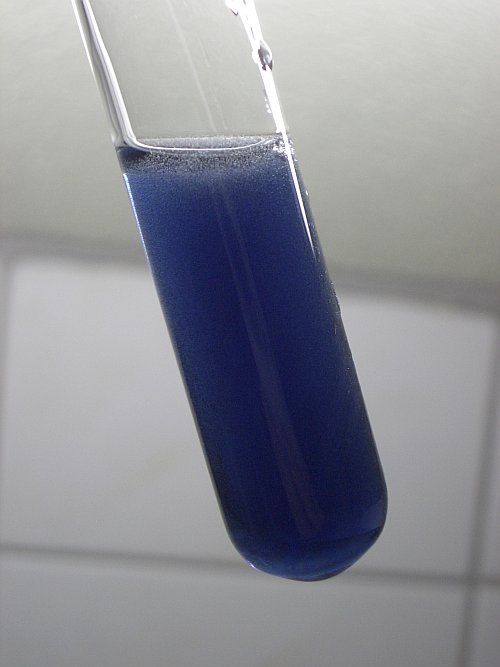
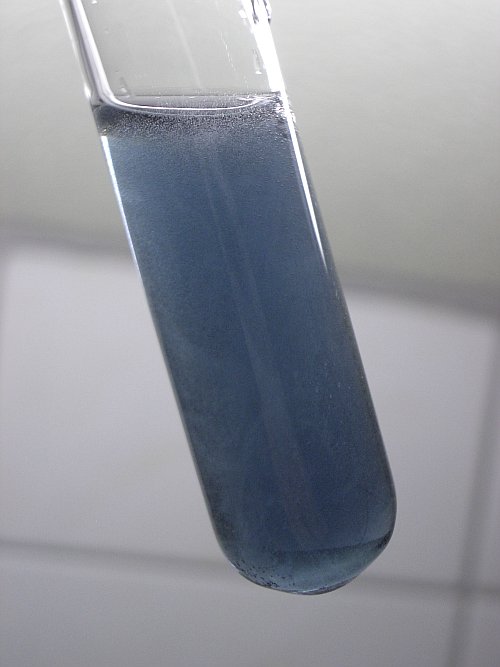
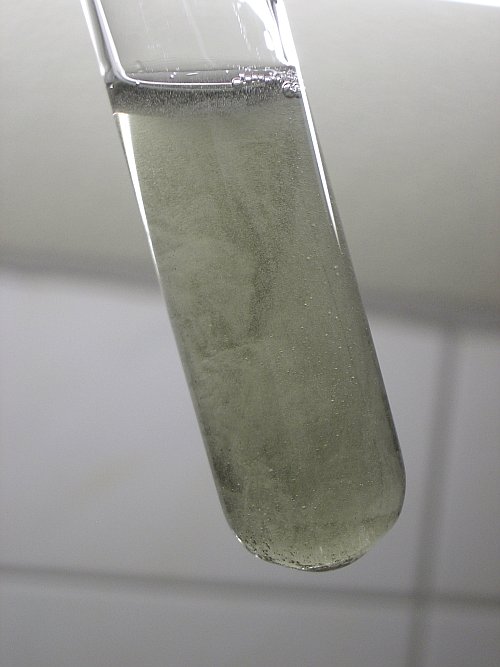
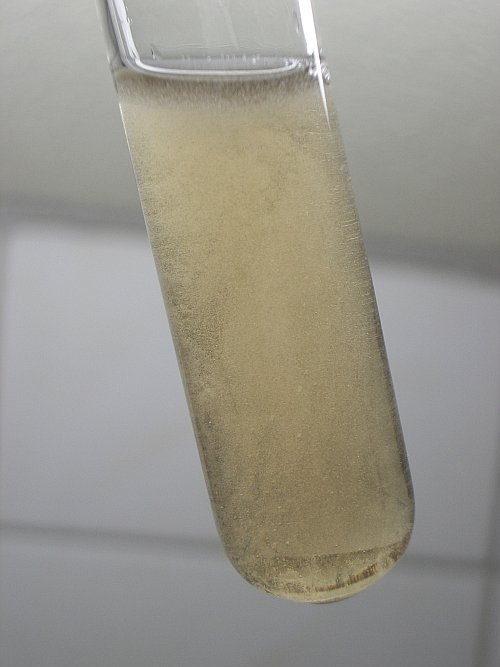
The zinc really is required for producing the brown color. When part of the light brown liquid is decanted, with the zinc remaining in the test tube, then the brown color darkens. Below, two pictures are shown, the left picture is 2 minutes after decanting the light brown liquid, the right picture is 5 minutes after decanting the light brown liquid.
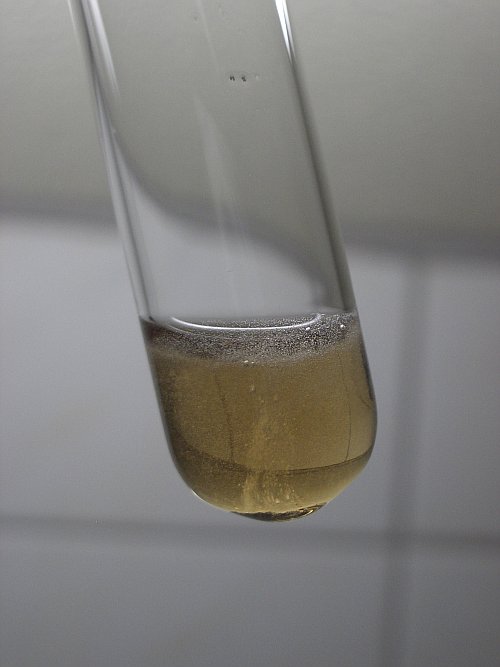
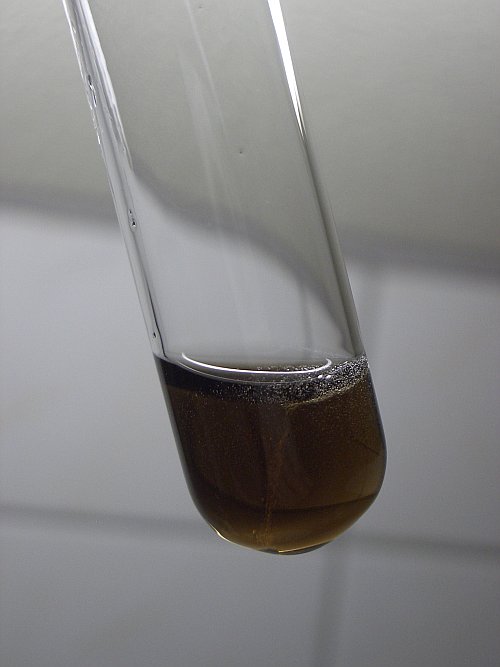
When the liquid is shaken with contact with air, then it becomes lighter again. The two pictures below show the same liquid, the left after shaking for 30 seconds, the right after shaking for a minute or 2, while assuring that fresh air can enter the test tube.
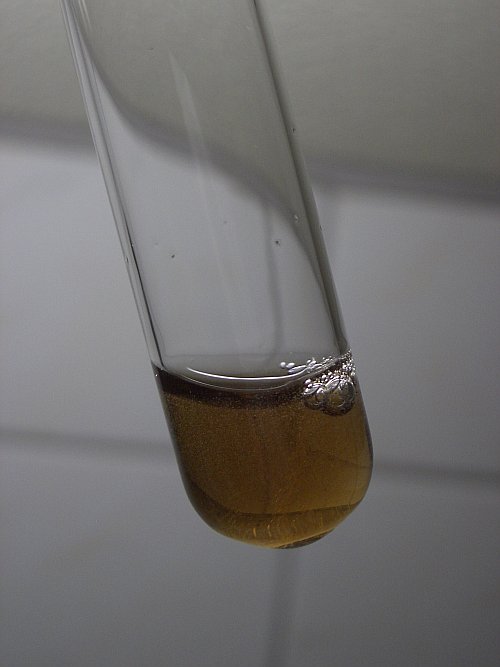
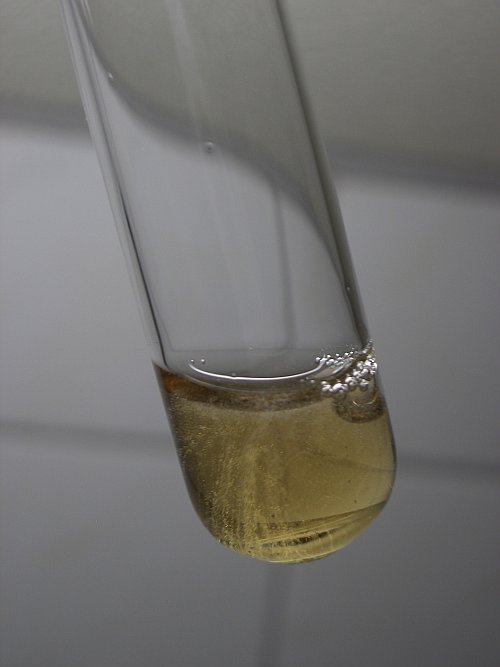
When the liquid is allowed to stand for a while, with the zinc still present, then it slowly turns darker again, but after a longer time, it finally becomes colorless, when all zinc is dissolved and it remains in contact with air.
So, the brown compound can be assumed to be a niobium compound of lower than +5 oxidation state, probably something between +4 and +5. It might be a mixed-oxidation state complex, which is strongly reducing. Oxygen from the air oxidizes the complex to a colorless compound, most likely NbOCl3, which contains niobium in its +5 oxidation state.
![]()
Oxidation state +5
The aqueous chemistry of niobium in its +5 oxidation state is limited, due to extreme tendency of hydrolysis. Even in concentrated hydrochloric acid, hydrolysis is quick, leading to formation of NbOCl3, followed by a much slower hydrolysis to hydrous Nb2O5.
When solid NbCl5 is added to water, then a lot of heat is produced, together with a hissing noise, and the solid quickly dissolves. A white turbid puddle is formed, consisting of hydrous Nb2O5, mixed with strong hydrochloric acid.
When solid NbCl5 is added to concentrated hydrochloric acid, then it also quickly dissolves, but in that case, much less heat is produced, and a lot of gas is produced, and a colorless solution is obtained. The gas is hydrogen chloride. The reason that less heat is produced is twofold. First, the NbCl5 is only hydrolysed to NbOCl3 in concentrated hydrochloric acid. Second, and probably most important, the HCl, formed during hydrolysis does not dissolve in the liquid. In concentrated hydrochloric acid, not much more HCl can be dissolved. In this way, the strong heat of hydration of HCl-gas is avoided.
The left picture below shows some solid NbCl5 in a test tube, the middle picture shows the test tube, after adding some concentrated hydrochloric acid. This picture shows the tail of the vigorous evolution of gas (it was more violent, just before the picture was made). The right picture shows the final result, immediately after all solid has dissolved. The liquid is totally colorless.
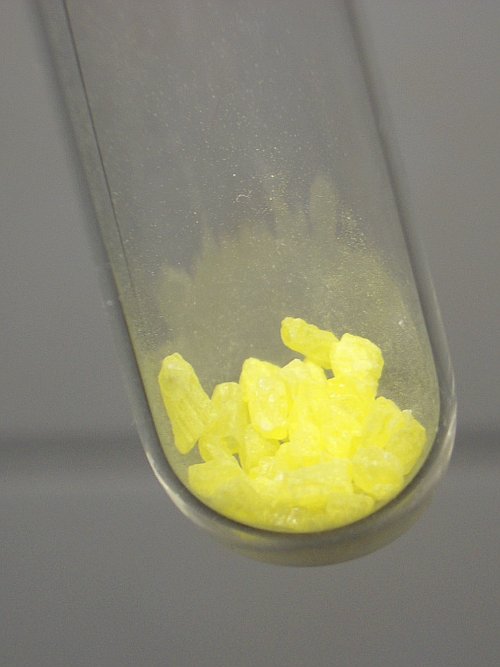
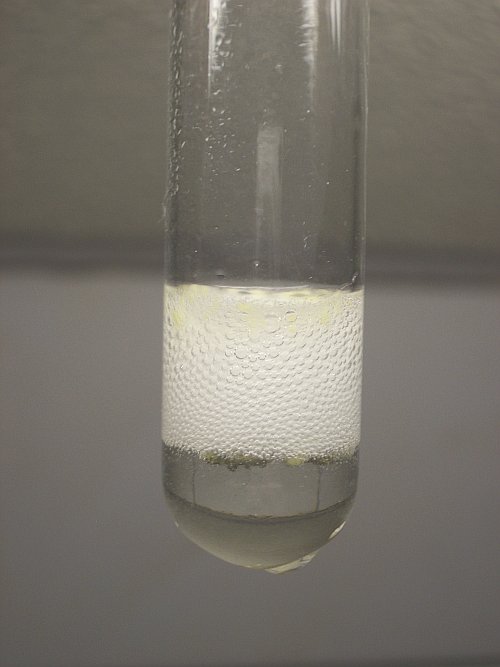

When the colorless liquid is allowed to stand for a while, then it slowly becomes turbid. Despite the very strong acidity, the hydrolysis continues and finally an hydrous oxide/hydroxide species is formed, which can best be described as Nb2O5.nH2O.
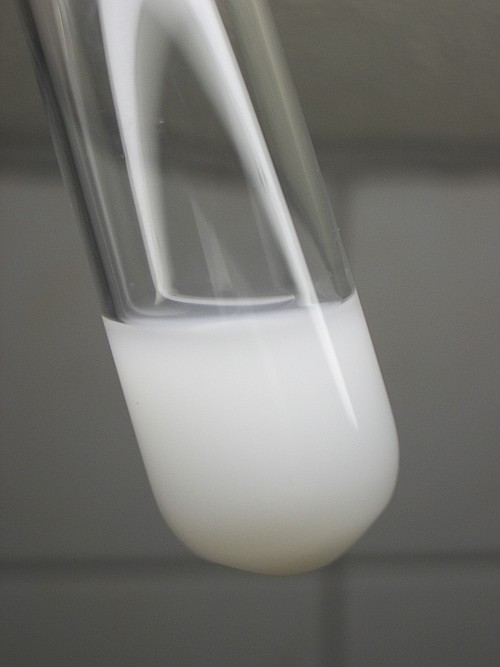
The reactions roughly can be described by the following equations:
Quick hydrolysis: NbCl5 + H2O → NbOCl3 + 2HCl
Slow hydrolysis on standing: 2NbOCl3 + 3H2O → Nb2O5 + 6HCl
NbOCl3 is a white solid, which is colorless in solution.
Nb2O5 is a white solid, which is very inert and totally insoluble.
![]()
Oxidation state +5, peroxo complex
When hydrogen peroxide is added to the colorless and strongly acidic solution, containing NbOCl3, then a deep yellow liquid is obtained. The picture below shows what happens when hydrogen peroxide (10% by weight) is added to a concentrated solution of NbCl5 in concentrated hydrochloric acid. As soon as the hydrogen peroxide is added, a lot of chlorine gas is produced, but besides that, the liquid becomes deep yellow at once. This yellow compound is a peroxo-species of niobium. This peroxo-species is more stable towards hydrolysis than plain niobium (V). This liquid does not become turbid on standing.
The picture shows the color of the peroxo species. The bubbling is due to formation of chlorine gas and decomposition of hydrogen peroxide to water and oxygen.
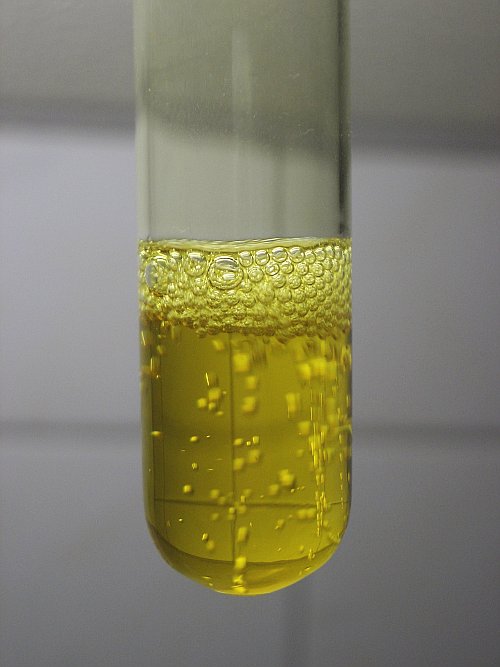
Even stronger, as mentioned above, when niobium pentachloride is added to water, then at once, the liquid becomes turbid, due to extensive hydrolysis of the niobium (V). In contrast, when solid niobium pentachloride is added to 10% hydrogen peroxide, then it dissolves, producing hydrogen chloride (and also some chlorine, due to oxidation by the hydrogen peroxide), but the liquid does not become turbid. Even without acid, the liquid remains clear with the hydrogen peroxide in solution. The picture below shows the result of adding some hydrogen peroxide (10%) to solid niobium pentachloride.

back to solutions/precipitates main page
back to miscellaneous main page